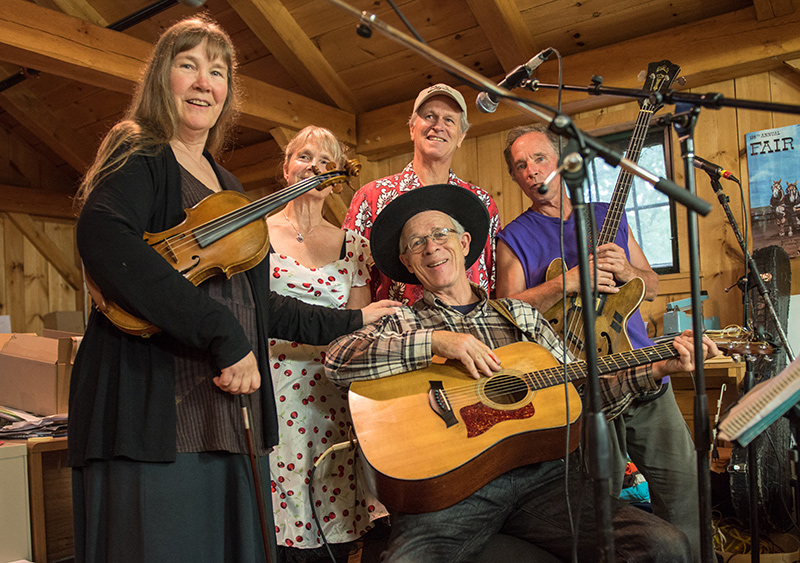
In 1800, a ship’s fiddler named William Litten sailed with the British India fleet. On Tuesday, the Flying Elbows will perform some of his tunes at the Martha’s Vineyard Museum as part of a concert series that showcases Island music and its history. The ship fiddler’s job was to play rhythmic tunes to accompany the sailors’ work, sparing them the need to sing undignified sea chanteys to keep in time together. Unlike many ship’s fiddlers, Litten was musically literate, and wrote down the tunes he played in his journal. Allen Coffin of Edgartown acquired Litten’s journal and brought it home with him. It’s possible that the two men sailed together in the British Navy, or even played music together, but all of that is speculation. Eventually, Litten’s logbook landed in the collection of the Dukes County Historical Society, the organization which is now known as the Martha’s Vineyard Museum, only to be discovered by another musician over a century later.
Gale Huntington was the founding editor of the Dukes County Intelligencer (now the MVM Quarterly) from 1959 to 1977. He taught Latin and history at the high school here, and was also a fisherman, musician, folksinger, and collector of sea chanteys. He discovered Litten’s manuscript in the historical society’s library, and copied the tunes in his own clear and legible handwriting. The resulting book, “William Litten’s Fiddle Tunes, 1800 – 1802,” includes historical notes on the tunes, as well as the music itself. A copy of the book, now out of print, found its way to the Flying Elbows, but there’s a good chance that some of the tunes would be part of their repertoire simply because they’re, as Nancy Jephcote put it, “old chestnuts, tunes that everyone knows.”
The Flying Elbows were founded in 1976, and a couple of the band’s current members knew Gale Huntington in their youth, and heard him play. “Coming up I heard Gale playing with Mike Athearn and Ernie Correllus,” said Tom Hodgson. “They were the Flying Elbows of their day.” Bob Hammond was 18 years old and just starting to play fiddle and banjo when he first saw Huntington play as part of a band called the Menemsha Bighters. “Hollis Smith was part of a band with Gale, and they were playing at a party up in Chilmark,” Hammond recalled. “It would have been around 1970. They drank something called ‘tuning fluid.’”
“Nobody knew what was in it,” Hodgson chimed in. “It was a glass bottle inside a paper bag, and it was pink. It was called liquid rosin.” The others agreed that yes, it was called liquid rosin, and Gale and his contemporaries drank it to keep their aging fingers lubricated — Huntington was born in 1902, so by the early 1970s he was getting into his 70s. In those days there weren’t many venues for music apart from private parties and occasional shows at the Ritz. There were some coffeehouses at the Stone Church and the youth hostel, but the famous Mooncusser coffeehouse of 1963–66 was long gone by the ’70s, and the Wintertide didn’t get started until the early ’80s. Now you can even hear live music at the museum.
The Flying Elbows will play in the Linnemann Pavilion, near the Fresnel lens from the Gay Head Lighthouse. Visitors will be able to wander by, stop to listen or dance, or hear the music as they look at the exhibits or enjoy dinner at the cafe. Tuesday evenings at the museum this summer will feature free admission and a series of special events, including this concert series. The series began with the Black Brook Singers, an Aquinnah Wampanoag group that performs new and traditional songs, and will continue with performances by Jim Kweskin, who played at the Mooncusser in the 1960s, and Kahoots, a local band that formed in the early 1990s. The Flying Elbows performance will begin at 6 pm, and at 7 pm there will be a special short program featuring songs published by Gale Huntington and played on Huntington’s own guitar, a 1954 Martin. The museum’s chief curator, Bonnie Stacy, wanted to make sure the instrument was in playable condition, and it’s also part of “Our Own Beat: 200 Years of Island Music,” the current special exhibit upstairs at the museum.
Other events will be announced as the summer progresses. “So many of the programs we’re doing this year are testing the waters,” says Anna Barber, manager of exhibitions and programming. “We’re trying out what works in the space of the new museum, to find out what resonates with the community and museum visitors. We wanted the museum to be a warm and welcoming place for people to visit. I love the idea that you’ll hear music throughout the building — we’re hoping to have music all over the museum this summer.”
This article by Amelia Smith originally appeared on mvtimes.com.



